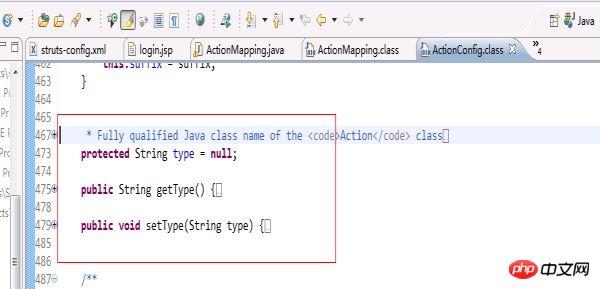關於Struts1之ActionMapping的範例詳解
這篇文章主要介紹了Struts1教學之ActionMapping,小編覺得挺不錯的,現在分享給大家,也給大家做個參考。一起跟著小編過來看看吧
首先斷點走出了processpath方法,
# 
這個方法是用來截取字串的,今天我們來看看怎麼獲得ActionMapping的方法---processMapping。
在此之前簡單說一下ActionMapping,它的原始程式碼中可以看出,其中最重要的屬性和我們的mvc小實例中的ActionMapping類似,都是有path、type還有forwardMap,主要是對應的struts-config設定檔而來,這個就是保存這個設定檔的資訊到記憶體中。
具體的mvc小實例的ActionMapping程式碼如下:
package com.cjq.servlet;
import java.util.Map;
public class ActionMapping {
private String path;
private Object type;
private Map forwardMap;
public String getPath() {
return path;
}
public void setPath(String path) {
this.path = path;
}
public Object getType() {
return type;
}
public void setType(Object type) {
this.type = type;
}
public Map getForwardMap() {
return forwardMap;
}
public void setForwardMap(Map forwardMap) {
this.forwardMap = forwardMap;
}
}而Struts中的Actionconfig(因為ActionMapping是繼承這個ActionConfig的,所以我們來看ActionConfig比較直接)的程式碼如下:



從這兩部分程式碼來看,更印證了我在開篇寫的mvc小實例是一個struts框架的雛形。
講完ActionMapping的一些內容後,相信對ActionMapping有所了解,那麼系統是如何產生ActionMapping和如何找到ActionMapping的呢?這就是今天要說的整體:
我們看下web.xml中有一個
進入斷點偵錯,先在processMapping方法上設定斷點。

進入原始程式碼中:
/**
* <p>Select the mapping used to process theselection path for this request
* If no mapping can be identified, createan error response and return
* <code>null</code>.</p>
*
* @param request The servlet request weare processing
* @param response The servlet response weare creating
* @param path The portion of the requestURI for selecting a mapping
*
* @exception IOException if an input/outputerror occurs
*/
protectedActionMapping processMapping(HttpServletRequestrequest,
HttpServletResponse response,
String path)
throws IOException {
// Is there a mapping for this path?
ActionMapping mapping = (ActionMapping)
moduleConfig.findActionConfig(path);
// If a mapping is found, put it in the request and return it
if (mapping != null) {
request.setAttribute(Globals.MAPPING_KEY, mapping);
return (mapping);
}
// Locate the mapping for unknown paths (if any)
ActionConfig configs[] = moduleConfig.findActionConfigs();
for (int i = 0; i < configs.length; i++) {
if (configs[i].getUnknown()) {
mapping = (ActionMapping)configs[i];
request.setAttribute(Globals.MAPPING_KEY, mapping);
return (mapping);
}
}
// No mapping can be found to process this request
String msg = getInternal().getMessage("processInvalid");
log.error(msg + " " + path);
response.sendError(HttpServletResponse.SC_NOT_FOUND, msg);
return null;
}首先我們傳入我們在上一步所截取的路徑,透過moduleConfig的findAction方法來找出ActionConfig,並且傳回ActionMapping。具體程式碼是:
ActionMapping mapping =(ActionMapping) moduleConfig.findActionConfig(path);
如果找到,那就講ActionMapping存放到request的context中。程式碼:
if (mapping != null) {
request.setAttribute(Globals.MAPPING_KEY, mapping);
return (mapping);
}如果沒有透過path找到mapping,則在Actionconfig中遍歷為未知路徑尋找mapping,如果找到則存放到request中,如果沒有找到,則回傳錯誤訊息,具體程式碼如下:
// Locate the mapping for unknownpaths (if any)
ActionConfig configs[] = moduleConfigfindActionConfigs();
for (int i = 0; i < configslength; i++) {
if (configs[i].getUnknown()) {
mapping = (ActionMapping)configs[i];
request.setAttribute(Globals.MAPPING_KEY, mapping);
return (mapping);
}
}
// No mapping can be found to process this request
String msg = getInternal().getMessage("processInvalid");
log.error(msg + " " + path);
response.sendError(HttpServletResponse.SC_NOT_FOUND, msg);
return null;來看下ActionServlet中的一個方法processActionForm,當我們在截取字串,再根據字串在取得ActionMapping(這是前兩篇文章中介紹的)之後,我們就要用利用ActionMapping來建立ActionForm了,並且把ActionForm放到request或session中管理。
先來看看特定struts中processActionForm方法的具體實作:
/**
* <p>Retrieve and return the <code>ActionForm</code> associatedwith
* this mapping, creating and retaining oneif necessary. If there is no
* <code>ActionForm</code> associated with this mapping,return
* <code>null</code>.</p>
*
* @param request The servlet request weare processing
* @param response The servlet response weare creating
* @param mapping The mapping we are using
*/
protectedActionForm processActionForm(HttpServletRequestrequest,
HttpServletResponse response,
ActionMapping mapping) {
// Create (if necessary) a form bean to use
ActionForm instance = RequestUtilscreateActionForm
(request, mapping, moduleConfig, servlet);
if (instance == null) {
return (null);
}
// Store the new instance in the appropriate scope
if (log.isDebugEnabled()) {
log.debug(" Storing ActionForm bean instance in scope '" +
mapping.getScope() + "' under attribute key '" +
mapping.getAttribute() + "'");
}
if ("request".equals(mapping.getScope())) {
request.setAttribute(mapping.getAttribute(), instance);
} else {
HttpSession session =requestgetSession();
session.setAttribute(mapping.getAttribute(), instance);
}
return (instance);
}這個方法的大體流程是:根據ActionMapping中的name名稱查找ActionForm,如果配置了ActionForm,那麼就到request或session中查找,如果在request或session中存在已經建立的ActionForm,那麼將會回傳。如果不存在那麼會根據ActionForm的完成路徑採用反射進行創建,再將創建好的ActionForm放到request或session中,之後再傳回ActionForm。
#具體我們可以跟隨斷點偵錯來看看這個方法是如何運作的。
先設定斷點,之後再進入processActionForm方法。
第一個步驟就是建立ActionForm:
// Create (if necessary) a formbean to use
ActionForm instance = RequestUtils.createActionForm
(request, mapping, moduleConfig, servlet);
if (instance == null) {
return (null);
}透過呼叫RequestUtils.createActionForm的方法把ActionMapping中的ActionForm字串產生對象,並且返回。進入這段程式碼:
publicstaticActionForm createActionForm(
HttpServletRequest request,
ActionMapping mapping,
ModuleConfig moduleConfig,
ActionServlet servlet) {
// Is there a form bean associated with this mapping?
String attribute = mappinggetAttribute();
if (attribute == null) {
return (null);
}
// Look up the form bean configuration information to use
String name = mapping.getName();
FormBeanConfig config =moduleConfigfindFormBeanConfig(name);
if (config == null) {
log.warn("No FormBeanConfig found under '"+ name + "'");
return (null);
}
ActionForm instance = lookupActionForm(request,attribute, mappinggetScope());
// Can we recycle the existing form bean instance (if there is one)?
try {
if (instance != null && canReuseActionForm(instance,config)) {
return (instance);
}
} catch(ClassNotFoundException e) {
log.error(servlet.getInternal().getMessage("formBean",config.getType()), e);
return (null);
}
return createActionForm(config,servlet);
}方法先定義變數name,並且從mapping取得值,String name = mapping.getName();也就是我們實例中的LoginForm字串。之後透過呼叫FormBeanConfig config =moduleConfig.findFormBeanConfig(name);這句話把對應的LoginForm字串產生對應的物件。
這裡要說明的是我們在struts-config設定檔中,配置過這樣一個標籤資訊:
<form-beans>
<form-bean name="loginForm" type=".struts.LoginActionForm"/>
</form-beans>这个标签在服务器一启动的时候就会利用digester读取这里的配置信息,并且放在FormBeanConfig类中,这样我们可以通过上面那一句话就可以把LoginForm字符串生成相应的对象。
之后调用了ActionForm instance = lookupActionForm(request,attribute, mapping.getScope());这个方法,这个方法主要是查找scope属性中有没有存在ActionForm。具体实现:
if ("request".equals(scope)){
instance = (ActionForm)request.getAttribute(attribute);
} else {
session = request.getSession();
instance = (ActionForm)session.getAttribute(attribute);
}这里判断scope属性值是否为request,如果是则从request中读出ActionForm,如果不是则从session中读出。程序如果是第一次执行,那么ActionForm会是为空的。因为这里的ActionForm为空,所以就进入了if判断语句中,最后通过调用return createActionForm(config, servlet);创建ActionForm并且返回。
之后processActionForm就会把返回来的ActionForm放入request或者session中。具体实现就是:
if ("request".equals(mapping.getScope())){
request.setAttribute(mapping.getAttribute(), instance);
} else {
HttpSession session =request.getSession();
session.setAttribute(mapping.getAttribute(), instance);
}到此为止,ActionForm就创建完成,当ActionForm创建完成之后,就要用其他的方法来往ActionForm中赋值了
以上是關於Struts1之ActionMapping的範例詳解的詳細內容。更多資訊請關注PHP中文網其他相關文章!

熱AI工具

Undresser.AI Undress
人工智慧驅動的應用程序,用於創建逼真的裸體照片

AI Clothes Remover
用於從照片中去除衣服的線上人工智慧工具。

Undress AI Tool
免費脫衣圖片

Clothoff.io
AI脫衣器

Video Face Swap
使用我們完全免費的人工智慧換臉工具,輕鬆在任何影片中換臉!

熱門文章

熱工具

記事本++7.3.1
好用且免費的程式碼編輯器

SublimeText3漢化版
中文版,非常好用

禪工作室 13.0.1
強大的PHP整合開發環境

Dreamweaver CS6
視覺化網頁開發工具

SublimeText3 Mac版
神級程式碼編輯軟體(SublimeText3)
 C++中的眾數函數詳解
Nov 18, 2023 pm 03:08 PM
C++中的眾數函數詳解
Nov 18, 2023 pm 03:08 PM
C++中的眾數函數詳解在統計學中,眾數指的是一組資料中出現次數最多的數值。在C++語言中,我們可以透過寫一個眾數函數來找出任意一組資料中的眾數。眾數函數的實作可以採用多種不同的方法,以下將詳細介紹其中兩種常用的方法。第一種方法是使用哈希表來統計每個數字出現的次數。首先,我們需要定義一個哈希表,將每個數字作為鍵,出現次數作為值。然後,對於給定的資料集,我們遍
 Win11管理員權限取得詳解
Mar 08, 2024 pm 03:06 PM
Win11管理員權限取得詳解
Mar 08, 2024 pm 03:06 PM
Windows作業系統是全球最受歡迎的作業系統之一,其新版本Win11備受矚目。在Win11系統中,管理員權限的取得是一個重要的操作,管理員權限可以讓使用者對系統進行更多的操作和設定。本文將詳細介紹在Win11系統中如何取得管理員權限,以及如何有效地管理權限。在Win11系統中,管理員權限分為本機管理員和網域管理員兩種。本機管理員是指具有對本機電腦的完全管理權限
 Oracle SQL中的除法運算詳解
Mar 10, 2024 am 09:51 AM
Oracle SQL中的除法運算詳解
Mar 10, 2024 am 09:51 AM
OracleSQL中的除法運算詳解在OracleSQL中,除法運算是一種常見且重要的數學運算運算,用來計算兩個數相除的結果。除法在資料庫查詢中經常用到,因此了解OracleSQL中的除法運算及其用法是資料庫開發人員必備的技能之一。本文將詳細討論OracleSQL中除法運算的相關知識,並提供具體的程式碼範例供讀者參考。一、OracleSQL中的除法運算
 C++中的取餘函式詳解
Nov 18, 2023 pm 02:41 PM
C++中的取餘函式詳解
Nov 18, 2023 pm 02:41 PM
C++中的取餘函數詳解在C++中,取餘運算子(%)用於計算兩個數相除的餘數。它是一種二元運算符,其運算元可以是任何整數型別(包括char、short、int、long等),也可以是浮點數型別(如float、double)。取餘運算子傳回的結果與被除數的符號相同。例如,對於整數的取餘運算,我們可以使用以下程式碼來實作:inta=10;intb=3;
 Vue.nextTick函數用法詳解及在非同步更新中的應用
Jul 26, 2023 am 08:57 AM
Vue.nextTick函數用法詳解及在非同步更新中的應用
Jul 26, 2023 am 08:57 AM
Vue.nextTick函數用法詳解及在非同步更新中的應用在Vue開發中,經常會遇到需要進行非同步更新資料的情況,例如在修改DOM後需要立即更新資料或在資料更新後需要立即進行相關操作。而Vue提供的.nextTick函數就是為了解決這類問題而出現的。本文將會詳細介紹Vue.nextTick函數的用法,並結合程式碼範例來說明它在非同步更新中的應用。一、Vue.nex
 php-fpm調優方法詳解
Jul 08, 2023 pm 04:31 PM
php-fpm調優方法詳解
Jul 08, 2023 pm 04:31 PM
PHP-FPM是一種常用的PHP流程管理器,用於提供更好的PHP效能和穩定性。然而,在高負載環境下,PHP-FPM的預設配置可能無法滿足需求,因此我們需要對其進行調優。本文將詳細介紹PHP-FPM的調優方法,並給予一些程式碼範例。一、增加進程數預設情況下,PHP-FPM只啟動少量的進程來處理請求。在高負載環境下,我們可以透過增加進程數來提高PHP-FPM的同時
 linux系統呼叫system()函數詳解
Feb 22, 2024 pm 08:21 PM
linux系統呼叫system()函數詳解
Feb 22, 2024 pm 08:21 PM
Linux系統呼叫system()函數詳解系統呼叫是Linux作業系統中非常重要的一部分,它提供了一種與系統核心互動的方式。其中,system()函數是常用的系統呼叫函數之一。本文將詳細介紹system()函數的使用方法,並提供對應的程式碼範例。系統呼叫的基本概念系統呼叫是使用者程式與作業系統核心互動的一種方式。使用者程式透過呼叫系統呼叫函數來請求作業系統
 PHP模運算子的作用及用法詳解
Mar 19, 2024 pm 04:33 PM
PHP模運算子的作用及用法詳解
Mar 19, 2024 pm 04:33 PM
PHP中的模運算子(%)是用來取得兩個數值相除的餘數的。在本文中,我們將詳細討論模運算子的作用及用法,並提供具體的程式碼範例來幫助讀者更好地理解。 1.模運算子的作用在數學中,當我們將一個整數除以另一個整數時,就會得到一個商和一個餘數。例如,當我們將10除以3時,商數為3,餘數為1。模運算子就是用來取得這個餘數的。 2.模運算子的用法在PHP中,使用%符號來表示模






